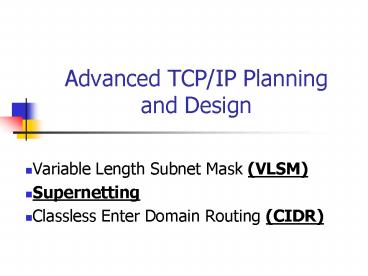Advanced TCPIP Planning and Design - PowerPoint PPT Presentation
1 / 9
Title:
Advanced TCPIP Planning and Design
Description:
Variable Length Subnet Mask (VLSM) Supernetting. Classless Enter Domain Routing (CIDR) ... subnet mask (VLSM) provide the capability to use different masks in ... – PowerPoint PPT presentation
Number of Views:50
Avg rating:3.0/5.0
Title: Advanced TCPIP Planning and Design
1
Advanced TCP/IP Planning and Design
- Variable Length Subnet Mask (VLSM)
- Supernetting
- Classless Enter Domain Routing (CIDR)
2
Variable-Length Subnet Mask
- Variable-length subnet mask (VLSM) provide the
capability to use different masks in a network
for different segments. - Large LANs could use a high bit-mask, while a
serial link could use a smaller bit-mask ( /30)
for two hosts (routers). - Not all routing protocols support VLSM
3
VLSM Case
172.17.0.0/20
- How Many IPs will be lost if one of the usable
subnets was used in a Point-to-point serial
connection???
4
VLSM Case
172.17.48.0/20
- How would VLSM be used to break one of the big
subnets into 8 smaller subnets where each subnet
would have only 512 hosts?? - How would VLSM be used to break one of the
512-host subnet into several smaller subnets that
would be used exclusively for serial links???
172.17.62.0/23
5
VLSM Case
172.17.48.0/23
172.17.62.0/30
Subnet bits ??? Host bits ???
Subnet bits ??? Host bits ???
172.17.0.0/20
6
Supernetting
- Supernetting groups networks into larger
supernets - How by borrowing bits from the network portion
of the address. - Why Say that you want a LAN network to have more
than 254 hosts a class C network is not
sufficient. You can group two Class C networks
using supernets. - Benefits Provide more IP addresses to the LAN
segment without using secondary IP addresses on
the router interface. (How would this effect the
ISP???) - Grouping classfull networks into supernets is
considered classless routing.
7
Supernetting Case
- Networks 192.168.4.0/24 and 192.168.5.0/24 are
Class C networks with a default mask of
255.255.255.0. - These two networks are the same up to 23 bits.
- They are combined or supernetted, into one
network192.168.4.0/23. - The mask for the new network is 255.255.254.0
- The first host address is 192.168.4.1.
- The last host address is 192.168.5.254.
- The broadcast address is 192.168.5.255.
8
Address Aggregation
- A set of classfull networks can also be
summarized in routing entries by creating
aggregate addresses at the supernet level. The
depicted figure shows how address aggregation
summarizes routes - in which Router A sends only one route,
208.10.8.0/22, to its upstream router.
9
Case
- Assume, for example, that network 172.17.0.0/16
will be used in a medium- to large-sized company
with nine areas. - Each area could have several sites.
- How can the network be divided allowing at least
2000 nodes per area? - Each area have the following
- Two large LANs with around 1000 hosts each
- Four medium LANs with 200 hosts,
- Five small LANs with 20 hosts,
- Reserved addresses for serial links
- Available room for future medium and small LANs.































